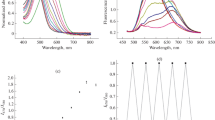Abstract
Lysosome selective bright orange-red emitting flavonoid (2) was synthesized by attaching a strong donor (NPh2) group into flavonoid skeleton. As a result of efficient intra molecular charge transfer due to the strong donor group, a significant bathochromic shift was observed from the emission of 2b (with a –NPh2 group, λem ≈ 590 nm), in comparison that of 1b (with a –NMe2 group, λem ≈ 519 nm). The role of the substituent effect towards ICT was further studied by low temperature spectral analysis. Fluorescence spectra at low temperature confirmed that large Stokes shift for probe 2 (Δλ ≈ 150 nm) was due to strong ICT. Probe 2b exhibited exceptional selectivity towards cellular lysosomes in live cells studies thus generating bright orange-red emission upon localization. Intra-cellular pH analysis results confirmed that probe 2b did not participate in the elevation of lysosomal pH upon staining with different probe concentrations (0.5 μM – 2.0 μM) which is a potential advantage compared to acidotropic commercial LysoTracker® probes. This study further illustrated that the substituents in probe 2 play a significant role towards probe’s organelle selectivity since probe 2a (R = OH) did not show any lysosomal localization compared with 2b. In addition, the calculated cytotoxicity data further revealed that this new probe design is highly biocompatible (LC50 > 50 μM) and suitable for long term imaging.

Graphical Abstract









Similar content being viewed by others
References
Johnson I, Spence MTZ (2010) The handbook: a guide to fluorescent probes and labeling technologies
Zhang J, Campbell RE, Ting AY, Tsien RY (2002) Creating new fluorescent probes for cell biology. Nat Rev Mol Cell Biol 3:906–918
Wiederschain GY (2011) The molecular probes handbook. A guide to fluorescent probes and labeling technologies. Biochem 76:1276–1276
McDonald L, Liu B, Taraboletti A, Whiddon K, Shriver LP, Konopka M, Liu Q, Pang Y (2016) Fluorescent flavonoids for endoplasmic reticulum cell imaging. J Mater Chem B 4:7902–7908
Liu B, Shah M, Zhang G, Liu Q, Pang Y (2014) Biocompatible flavone-based fluorogenic probes for quick wash-free mitochondrial imaging in living cells. ACS Appl Mater Interfaces 6:21638–21644
Havsteen BH (2002) The biochemistry and medical significance of the flavonoids
Zhao C, Liu B, Bi X, Liu D, Pan C, Wang L, Pang Y (2016) A novel flavonoid-based bioprobe for intracellular recognition of Cu2+ and its complex with Cu2+ for secondary sensing of pyrophosphate. Sensors Actuators B Chem 229:131–137
Pietta PG (2000) Flavonoids as antioxidants. J Nat Prod 63:1035–1042
Hertog MGL, Feskens EJM, Kromhout D, Hertog MGL, Hollman PCH, Hertog MGL, Katan MB (1993) Dietary antioxidant flavonoids and risk of coronary heart disease: the Zutphen elderly study. Lancet 342:1007–1011
Litvinov VP (2007) Chemistry and biological activities of 1,8-naphthyridines. Russ Chem Rev 73:637–670
Chahar MK, Sharma N, Dobhal MP, Joshi YC (2011) Flavonoids: a versatile source of anticancer drugs. Pharmacogn Rev 5:1–12
Cushnie TPT, Lamb AJ (2005) Antimicrobial activity of flavonoids. Int J Antimicrob Agents 26:343–356
Cooper G (2000) The Cell: A Molecular Approach, 2nd ed. Sinauer Associates, Sunderland (MA)
Chen X, Bi Y, Wang T, Li P, Yan X, Hou S, Bammert CE, Ju J, Gibson KM, Pavan WJ, Bi L (2015) Lysosomal targeting with stable and sensitive fluorescent probes (superior LysoProbes): applications for lysosome labeling and tracking during apoptosis. Sci Rep 5:9004–9013
Bertman KA, Abeywickrama CS, Baumann HJ, Alexander N, McDonald L, Shriver LP, Konopka M, Pang Y (2018) A fluorescent flavonoid for lysosome detection in live cells under “wash free” conditions. J Mater Chem B 6:5050–5058
Novakova V, Hladík P, Filandrová T, Zajícová I, Krepsová V, Miletin M, Lenčo J, Zimcik P (2014) Structural factors influencing the intramolecular charge transfer and photoinduced electron transfer in tetrapyrazinoporphyrazines. Phys Chem Chem Phys 16:5440–5446
Acknowledgments
We acknowledge partial support from Coleman Endowment from The University of Akron. We thank Nicolas Alexander from The University of Akron for acquiring mass spectra data. We also thank Hannah J Baumann from The University of Akron for conduction MTT cell viability assays. The NHLF cell line was a kind gift from Dr. Sailaja Paruchuri at The University of Akron.
Author information
Authors and Affiliations
Corresponding author
Additional information
Publisher’s Note
Springer Nature remains neutral with regard to jurisdictional claims in published maps and institutional affiliations.
Electronic supplementary material
ESM 1
(DOCX 5.37 mb)
Rights and permissions
About this article
Cite this article
Bertman, K.A., Abeywickrama, C.S., Ingle, A. et al. A Fluorescent Flavonoid for Lysosome Imaging: the Effect of Substituents on Selectivity and Optical Properties. J Fluoresc 29, 599–607 (2019). https://doi.org/10.1007/s10895-019-02371-7
Received:
Accepted:
Published:
Issue Date:
DOI: https://doi.org/10.1007/s10895-019-02371-7




